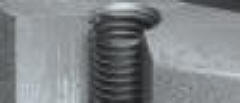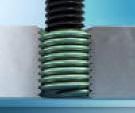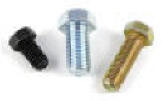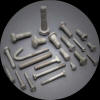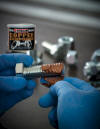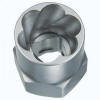|
Fastener Faults |
|
Videos |
|
There
are
various
other
methods
of
joining
parts
together
so
that
they
can
be
easily
assembled
and
dismantled.
Below
are
just
a
few
types
of
other
fasteners
|
-
Incorrect torque:
Tightening a fastener too much or too little can cause
it to fail.
-
Stripped threads:
This can happen if a fastener is over- or
under-tightened, or if the wrong length fastener is
used.
-
Corrosion: Bolts can corrode when
exposed to incompatible substances like oxygen, metal
products, and chemicals.
-
Hydrogen embitterment: This is a
major cause of fastener failure, and is thought to
affect steels with Rockwell hardness above C30.
-
Fatigue and fracture: This can happen
due to improper installation, and is a significant
structural problem in fastener tension joints.
- Excessive application of cyclic
loading: This happens when the dynamic load exceeds the
fastener's clamping load.
- Impact shear: This can happen in
bolts loaded in single shear, such as flywheel bolts and
ring gear bolts.
- Excess stress on bolts: This can
cause bolts to break.
-
A stripped bolt head, or lug nut, is when
the head has rounded off. Here are some ways to remove a
rounded bolt
|
|
Incorrect torque |
|
If the torque is not applied correctly and
the tension on the bolt torque is too low, varying loads
will act upon the bolt and fail. Proper torque control
during the tightening of bolts ensures that they are
securely fastened. Loose bolts can loosen over time from
constant vibrations. |
- Choose the right
torque wrench
- Calibrate the torque wrench
- Set the torque value
- Align the torque wrench
- Apply the torque force
- Ensure right torque sequence with multiple bolts eg.
Cylinder head
- Reset the torque wrench
|
|
|
|
|
|
Striped Screw Threads |
|
Striped threads occur when the strength of
the threaded material is exceeded by the applied forces
acting on the thread, causing a shear failure. Internal as
well as external threads can strip. |
|
Main reasons for stripping screw threads |
- Over tightening of nuts and bolts
- Not having nut or bolt square when
starting
- No matching pitch and diameter sizes
- Dirt in threads
|
|
Damaged internal thread can be repaired by
enlarging hole and up the diameter of the bolt. If this is
not possible then helicoill can be used tor repair internal
thread |
|
|
|
A Helicoil, also known as a screw thread
insert or helical insert, is a stainless steel wire with a
diamond-shaped cross-section that can repair stripped
threads in hard metals like steel, or soft materials like
wood or plastic. Helicoils are used in many industries,
including mechanical engineering, electronics, automotive,
and aerospace. They come in two versions: Free Running and
Screw lock, and are available in green or red to make them
easy to identify when installed. |
|
|
|
|
|
Corrosion |
|
It occurs when two different types of metal
are joined, and electricity flows from one to the other,
leaving behind corrosion. Uniform Corrosion: This occurs
across the entire surface area of a fastener when it's not
properly coated or plated. |
|
To prevent corrosion the following can be
done: |
- Use stainless steel fasteners
- Use electroplated fasteners
- Use galvanised fasteners
- Cover with grease or copper slip
|
|
|
|
|
|
Hydrogen embrittlement |
Hydrogen embrittlement (HE) is a dangerous
reaction that occurs when hydrogen diffuses into a metal,
causing it to become brittle. This can happen during
welding, casting, pickling, or cathodic protection. The
degree of embrittlement is determined by the amount of
hydrogen absorbed and the microstructure of the material.
|
|
|
|
|
|
Fatigue is a common failure of fasteners
during random vibration, especially after the loss of bolt
pre-tension. Fatigue causes an estimated 90% of all
mechanical service failures. Fatigue cracks usually
initiate in the thread roots but can also initiate under the
bolt head. Often failure in this location is the result of
an inadequate under head radius (resulting in a high stress
concentration) or the bolt being mounted on an inclined
surface. |
|
|
|
|
|
|
|
Stripped bolt head |
|
Striped head bolts and nuts heads normally
happens if you use a wrong size spanner or a shifting
spanner. The use of shifting spanners should be
limited. |
|
|
|
Here are some ways to remove a stripped
bolt head: |
- Bolt extractor kit: These kits have
cone-like tips that dig into the metal to grip the bolt.
- Locking pliers: Turn the adjustment
screw so the teeth grip the bolt head, then lock the
pliers and turn the bolt counter clockwise.
- Drill: Drill directly into the head
and shank of the bolt to create a new pilot hole.
- Hair dryer: Apply heat to the bolt
head for one to two minutes, then let it cool.
- Blowtorch: Heat the bolt for a few
minutes, then let it cool. Apply penetrating oil and try
to wiggle the bolt free with pliers or a wrench.
- Welding: The heat from welding the
bolt onto a broken fastener can break corrosion bonds
between the threads.
- Torx wrench: Use a similarly sized
Torx wrench to remove a stripped Allen-head bolt. The
star shape can bite into the corners for more purchase.
- Rubber band or steel wool: Place a
rubber band or steel wool over the bolt head and press a
tool into it and the bolt head to provide extra grip.
- Make use of a nut spliier
|
|
|
|
|
|
|






